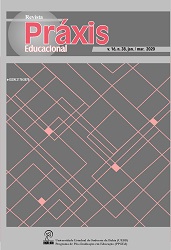MODELLING THE CONSTRUCT OF BURNOUT PREVENTION: THE CASE OF SUPERVISORS’ PERCEPTIONS
DOI:
https://doi.org/10.22481/praxisedu.v16i38.6017Palavras-chave:
Burnout, prevenção de burnout, fontes de prevenção de burnout, construção de prevenção de burnoutResumo
A sobrecarga de trabalho do professor pode causar desafios para os professores, levando a esgotamento a longo prazo, se não forem abordados. Consequentemente, o presente estudo tem como objetivo examinar as fontes de prevenção de burnout das perspectivas dos supervisores de EFL (inglês como língua estrangeira). Os participantes foram 85 supervisores iranianos de EFL, cujo trabalho era observar e dar feedback aos professores sobre seu desempenho no ensino em vários níveis de proficiência linguística, do nível básico ao avançado. Um projeto de método misto seqüencial foi empregado neste estudo. Primeiro, a coleta de dados qualitativos foi realizada por meio de entrevistas com 30 participantes, a fim de determinar as fontes de prevenção de burnout na perspectiva dos supervisores. A seguir, foi elaborado um questionário de prevenção de burnout, utilizando os resultados das entrevistas, após o qual foi aplicado aos demais participantes. Os dados coletados foram analisados por fatores para identificar os componentes do construto de prevenção de burnout. Os resultados da análise de conteúdo dos dados da entrevista indicaram que o apoio dos professores de seus colegas, a situação menos estressante e a satisfação no trabalho foram as principais fontes de prevenção de burnout. A análise fatorial mostrou as mesmas fontes de burnout que os principais componentes do construto de prevenção de burnout. As conclusões deste estudo enfatizam a contribuição do apoio educacional e emocional dos professores, proporcionando um local de trabalho construtivo e saudável, bem como a renda desejável como formas de prevenção do esgotamento nos professores de EFL.
Downloads
Metrics
Referências
Bastas, M. (2016). Development of the teacher’s burnout scale. Anthropologist, 23(1, 2), 105-114.
Belias, D., & Koustelios, A. (2014). Leaderrship and job satisfaction - A review. European Scientific Journal, 10(8), 24-46.
Buonomo, I., Fatigante, M., & Fiorilli, C. (2017). Teachers' burnout profile: Risk and protective factors. The Open Psychology Journal, 10, 190-201.
Clandinin, D. J. (2014). Narrative conceptions of knowledge: Towards understanding teacher attrition. Bingley, United Kingdom: Emerald Group Publishing Limited.
Edmonson, S. (2006). Role ambiguity. In F. W. English, Encyclopedia of educational leadership and administration (Vols. 1-2). Thousand Oaks, CA: SAGE Publications, Inc.
Heidari, S., & Gorjian, B. (2017). The effect of the level of English teachers' burnout on the EFL learners' general English achievement at senior high school. Journal of Applied Linguistics and Language Learning, 3(2), 41-47.
Fernet, C., Guay, F., Senecal, C. B., & Austin, S. L. (2012). Predicting intraindividual changes in teacher burnout: The role of perceived school environment and motivational factors. Teaching and Teacher Education. An International Journal of Research and Studies, 28(4), 514-525.
Friedman, I. A. (1995). Measuring school principal-experienced burnout. Educational and Psychological Measurement, 55(4), 641-651.
Ghanizadeh, F., & Jahedizadeh, S. (2016). EFL teachers’ teaching style, creativity, and burnout: A path analysis approach. Cogent Education, 3, 1-17.
Gruenert, S., & Whitaker, T. (2015). School culture rewired: How to define, assess, and transform it. Alexandria, VA: Association for Supervision and Curriculum Development.
Jacobson, T. (2016). Entanglement equilibrium and the Einstein equation. Physical review letters, 116(20), 201101.
Khajavy, G. H., Ghonsooly, B., & Fatemi, A. H. (2017). Testing a burnout model based on affective-motivational factors among EFL teachers. Current Psychology, 36(2), 339-349.
Kuntz, J. R. C., Näswall, K., & Bockett, A. (2013). Keep calm and carry on? An investigation of teacher burnout in a post-disaster context. New Zealand Journal of Psychology, 42(1), 83-97.
Leiter, M. P., & Maslach, C. (2011). Banishing burnout: Six strategies for improving your relationship with work. Hoboken, NJ: John Wiley & Son’s Publishing.
Maroofi, S., & Ghaemi, H. (2016). On the relationship between EFL teachers’ on the relationship between EFL teachers’ burnout and their affective construct burnout and their affective construct. Journal of Studies in Learning and Teaching English, 5(2), 55-88.
Marzano, R. J., & Heflebower, T. (2012). Teaching and assessing 21st century skills. Bloomington, IN: Marzano Research Laboratory.
Maslach, C. (1993). Burnout: A multi-dimensional perspective. In W. B. Schaufeli, C. Maslach & T. Marek (Eds.), Professional burnout: Recent developments in theory and research (pp. 19–32). Washington, DC: Taylor and Francis.
Maslach, C., Schaufeli, W. B., & Leiter, M. P. (2001). Job burnout. Annual Review of Psychology, 52, 397-422.
Paula, B., & Antonino, C. (2011). Teachers’ burnout: A comparison between lay and consecrated teachers. International Journal of Developmental and Educational Psychology, 1(3), 1-13.
Rashtchi, M. & Mashhoor, H. S. (2019). Extravert and Introvert EFL Teachers: How do Reflective Teaching and Burnout Relate? Journal of Applied Linguistics and Language Research, 6(3), 73-88.
Roohani, A. & Dayeri, K. (2019). On the Relationship between Iranian EFL Teachers’ Burnout and Motivation: A Mixed Methods Study. Iranian Journal of Language Teaching Research 7(1), 77-99.
Rostami, S., & Ghanizadeh, A. (2015). A study of contextual precursors of burnout among EFL teachers. International Journal of Research Studies in Psychology, 4.
Sadeghi, A. (2016). Surveying the relationship between personality traits and self-esteem with job satisfaction. Psychology, 7(05), 655.
Schmidt, R., Boraie, D., & Kassabgy, O. (1996). Foreign language motivation: Internal structure and external connections. University of Hawai'i Working Papers in English as a Second Language 14(2).
Shamsafrouz, H., & Haghverdi, H. (2015). The effect of burnout on teaching performance of male and female EFL teachers in L2 context. International Journal of Foreign Language Teaching & Research, 3(11), 47-59.
Steiner, K. D. (2017). A qualitative analysis of primary school teachers’ burnout patterns. The New Educational Review, 179-189.
Zarafshan, H., Mohammadi, M. R., Ahmadi, F., & Arsalani, A. (2013). Job burnout among Iranian elementary school teachers of students with autism: A comparative study. Iranian journal of psychiatry, 8(1), 20-28.
Downloads
Publicado
Como Citar
Edição
Seção
Licença
Você é livre para:
Compartilhar - copia e redistribui o material em qualquer meio ou formato; Adapte - remixe, transforme e construa a partir do material para qualquer propósito, mesmo comercialmente. Esta licença é aceitável para Obras Culturais Livres. O licenciante não pode revogar essas liberdades, desde que você siga os termos da licença.
Sob os seguintes termos:
Atribuição - você deve dar o crédito apropriado, fornecer um link para a licença e indicar se alguma alteração foi feita. Você pode fazer isso de qualquer maneira razoável, mas não de uma forma que sugira que você ou seu uso seja aprovado pelo licenciante.
Não há restrições adicionais - Você não pode aplicar termos legais ou medidas tecnológicas que restrinjam legalmente outros para fazer qualquer uso permitido pela licença.










